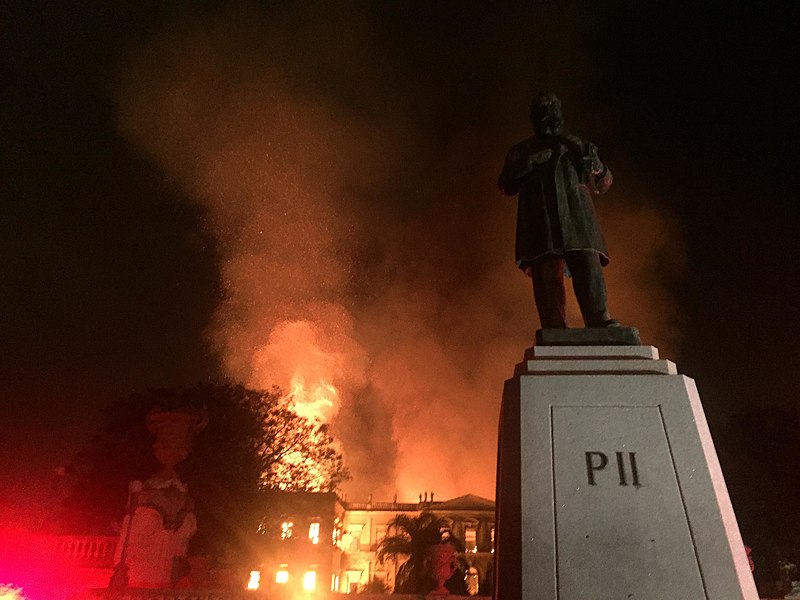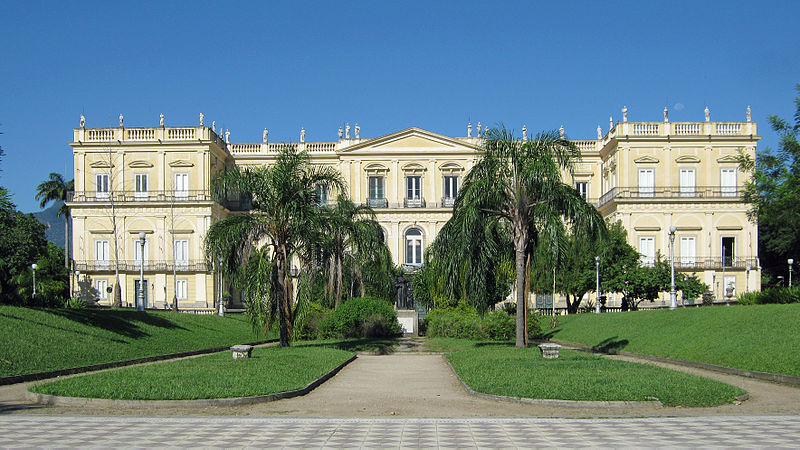
RIO DE JANEIRO (AP) – Forensic investigators and researchers awaited access Tuesday to the National Museum of Rio de Janeiro, gutted in a fire, to find out how the blaze began and what remains of the 20 million artifacts that made the museum one of the most important in Latin America.
After a fire tore through the museum Sunday, engineers were doing tests on the structure to make sure it wouldn’t collapse. Authorities had expressed concern Monday that internal walls and parts of the roof were weak.
Reportedly, there were fire extinguishers present, however it was not clear if there were sprinklers, which are problematic for museums because water can damage objects.
The building was still standing Monday morning, but much of it appeared to have been gutted. A few hundred protesters who gathered outside the museum gates tried several times to push into the site. They demanded to see the damage and called on the government to rebuild. Police pushed the crowd back with pepper spray, tear gas and batons.
Officials suggested that the damage could be catastrophic, with one official telling a Brazilian news outlet that as much as 90 percent may have been destroyed. The museum’s director said it was not possible yet to detail the losses.
The collection of 20 million items included Egyptian and Greco-Roman artifacts, Latin America’s largest collection of historical and scientific artifacts, and the oldest human skull found in the Western hemisphere. The building was once the home of the Portuguese royal family.
The cause of the fire was not known. Federal police will investigate since the museum was part of the Federal University of Rio de Janeiro. But protesters, commentators and museum directors themselves said years of government neglect had left the museum so underfunded that its staff had turn to crowdfunding sites to open exhibitions. In another example of struggling public services, firefighters initially struggled to contain it because the hydrants closest to the museum did not work. Instead, trucks had to gather water from a nearby lake.
Roberto Leher, rector of the Federal University of Rio de Janeiro, said it was well known that the building was vulnerable to fire and in need of extensive repairs. In fact, the institution had recently secured approval for nearly $5 million for a planned renovation, including an upgrade of the fire-prevention system, but the money had not yet been disbursed.
On Monday, officials promised $2.4 million to shore up the building and promised to rebuild the museum.
“Those saying that the museum will be rebuilt are not telling the truth,” said Luiz Philippe de Orleans e Braganca, an heir to Brazil’s last emperor. “The building could be rebuilt, but the collection will never again be rebuilt. Two hundred years, workers, researchers, professors that dedicated in body and soul (to the museum) … the work of their life burned due to the negligence of the Brazilian state.”

Luiz Fernando Dias Duarte, the museum’s deputy director, said that anything held in the main building was likely destroyed, and Cristiana Serejo, a vice-director of the museum, told the G1 news portal that maybe around 10 percent of the collection had survived. It included the largest meteorite ever discovered in Brazil — one of the few objects that officials could confirm had survived. Also, some parts of the collection were held at other sites and thus spared.
For many in Brazil, the state of the 200-year-old natural history museum quickly became a metaphor for what they see as the gutting of Brazilian culture and life during years of corruption, economic collapse and poor governance.
Brazil has struggled to emerge from a two-year recession and seen its political and corporate elite jailed in Latin America’s largest corruption investigation. The country has been riven with deep political divisions following the impeachment and removal of former President Dilma Rousseff.
___
By PETER PRENGAMAN and SARAH DiLORENZO
Associated Press
DiLorenzo reported from Sao Paulo.
___
National Museum website: http://www.museunacional.ufrj.br/
Copyright 2018 Associated Press. All rights reserved. This information may not be published, broadcast, rewritten, or redistributed.


